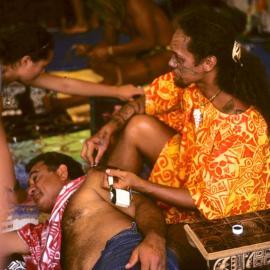Tattoos have become remarkably popular in recent decades. Once associated mainly with sailors and military personnel (as well as convicts, bikers, and other “marginal” groups) in Western society, today they are virtually commonplace.
As observed in the BBC News, “Would-be prime ministers' wives have them. Lawyers have them. Doctors have them. So how did tattoos become so acceptable?”
While their popularity may be at record levels today, tattoos themselves are nothing new, dating back at least 5,000 years. One of the most remarkable archaeological discoveries of the late twentieth century was the discovery of a frozen but extremely well-preserved man, 5,300-years old, in the Tyrolean Alps. Subject to extensive archaeological and biomedical research, this Neolithic-age individual—Ötzi, as he has since been named—has yielded an unprecedented array of information on his diet, health, genetic affiliation, technology, and much more. Plus one unexpected discovery—a series of tattoos, the oldest ever found. Arrayed in groups of short, parallel lines, crosses and other forms found alongside his spine, behind one knee, and on both ankles, these tattoos were possibly intended to relieve pain caused by his osteoarthritis and other degenerative conditions (see Dorfer et al. 1999).
While tattoos are known from other archaeological contexts (e.g., Siberia, Greenland, Peru), there is also extensive ethnographic and historic documentation of this practice from the Americas, Asia, the Sahara, Indonesia, the South Pacific, and elsewhere. Determining their “purpose” and what they “mean” to the cultural group utilizing them is a challenge, given that the images used and their placement (body, facial) vary widely, subject to group expectations, clan or totemic affiliation, gender, spiritual needs, and other factors. What’s most evident is that traditional forms of body modification are not simply ornamentation.
In contemporary Western society tattoos have emerged as a form of personal expression, commitment, rebellion, affiliation, or coming-of-age ritual. They have become a cross-cultural, multi-generational phenomenon, of great interest, anthropologically speaking. The designs themselves vary considerably, representing many different artistic traditions, including so-called “tribal art” that ranges from Native American to Celtic. Not surprisingly, a host of intellectual property issues have emerged (raised by both source communities and tattoo artists) regarding the use of certain images used out of context, sometimes in culturally inappropriate or unwelcome ways.
To be sure, many tattoo artists and recipients are cognizant of ethical and intellectual property issues, particularly relating to derivative vs. original artwork. But while some of those obtaining tattoos are drawn to tribal images as a way to honor the values of Indigenous peoples, they may be unaware that the use of those images outside of their original context is unappreciated by those whose cultural elements are being utilized. There are numerous instances of tribal symbols being used without permission of the source community. One of the best-known examples of this relates to the appropriation of Maori tattoo forms, as in the case of boxer Mike Tyson’s facial tattoo, which is a stylized version of the traditional ta moko. At the time there was a strong response to this by various Maori, objecting to this use of their intellectual property. Ironically, this controversy recently took a different form when Tyson’s tattooist Victor Whitmill claimed copyright infringement and sued Warner Brothers for allowing his work to be replicated on the face of an actor in the film “The Hangover 2” (Stickland 2009).
Indigenous people have also been drawn to tattooing for the same reasons as their non-Native counterparts. Many turn to tattoos as an expression of Native pride and cultural continuity, whether or not tattooing is part of their direct heritage. In recent years, some tattooing practices have been revitalized by members of certain Indigenous groups, as an explicit visual statement of their Indigeneity. This is evident in the Northwest Coast, for example, where clan crests may be worn by clan members. Likewise, a significant number of contemporary Maori continue their tradition of facial tattoos (Ngahuia Te Awekotuku 2012).
In a recent article on cultural expression and traditional knowledge, Miranda Forsysth provides an informative exploration of Samoan tattooing (tatau) relating to “who should have the right to control access to, and benefit from, traditional knowledge and intangible cultural heritage” (2012: 1) — a question also being explored by IPinCH. Forsyth discusses the Samoan case relative to issues of community or group ownership and control of heritage and attempts to protect traditional knowledge through regional and national legislation. Importantly, her case studies reveal the challenges faced by communities in preserving but also capitalizing on aspects of their cultural practices and knowledge. This is an important study because it seeks to tease apart the notions of commodification and appropriation, based on empirical research and theoretical exposition, which is also the case for Maureen Schwarz’s (2006) study of traditional and other tattoos amongst contemporary Native Americans relative to issues of spirituality and identity.
There is clearly the need for further exploration of the intellectual property issues associated with tattooing in both its traditional and contemporary contexts. For example, while customary laws governing who had the right to the ta moko once effectively restricted this particular type of tattoo, contemporary practices well beyond the Maori homeland reveal that new forms of control, or at least education, are needed.
While ostensibly no different from other forms of cultural borrowing or appropriation, tattooing operates at a much deeper, more personal, and more permanent level, and spans social, economic, and ethnic categories. Facilitating dialogue between tattoo artists, their clients, and members of source communities will help to provide a fuller understanding of the nature of the tattooing phenomenon and the cultural costs and benefits associated with it, relative to heritage values. There is also a great opportunity to use tattoos as a platform for discussing intellectual property in the classroom, given that many students might have or be considering tattoos.
IPinCH will be exploring this topic further, with the idea of developing a forum for discussion about tattoos, heritage, and IP, exploring the the idea of a podcast on the topic, and through other means.
References Cited
Dorfer, L., M. Moser, F. Bahr, K. Spindler, E. Egarter-Vigl, S. Giullén, G. Dohr, and T. Kenner. 1999. A Medical Report from the Stone Age? The Lancet 354 (9183): 1023–1025.
Forsyth, Miranda. 2012 Lifting the Lid on “The Community”: Who Has the Right to Control Access to Traditional Knowledge and Expressions of Culture. International Journal of Cultural Property 19: 1-31.
Schwarz, Maureen Trudelle. 2006. Native American Tattoos: Identity and Spirituality in Contemporary America. Visual Anthropology 19: 223-254.
Stickland, April 2009. Legal Ta Moko-Over: Maori Tattooing, Copyright, and “The Hangover 2.” Materialworld Blog.
Ngahuia Te Awekotuku. 2012. The Rise of the Maori Tribal Tattoo. BBC News Service.
Further Reading
Lars Krutak – Tattoo Anthropologist Website.
Krutak, Lars. 2007. The Tattooing Arts of Tribal Women. Bennett and Bloom, London.
Pabst, M.A., I. Letofsky-Papst, E. Bock, M. Moser L. Dorfer, E. Egarter-Viglf , and F. Hofer. 2009 The Tattoos of the Tyrolean Iceman: A Light Microscopical, Ultrastructural and Element Analytical Study. Journal of Archaeological Science 36: 2335-2341.
Spindler, Konrad. 1994. The Man in the Ice: The Preserved Body of a Neolithic Man Reveals the Secrets of the Stone Age. Weidenfeld and Nicolson, London.
Thomas, Nicholas, Anna Cole, and Bronwen Douglas (eds.). 2005. Tattoo: Bodies, Art, and Exchange in the Pacific and the West. Duke University Press, Durham.
Photograph: Traditional Samoan tattooing at a cultural festival, Auckland, New Zealand, 1996. G. Nicholas, used with permission.
The Appropriation (?) of the Month feature, written by IPinCH team members, highlights examples of uses of intellectual property that might be considered appropriations.






